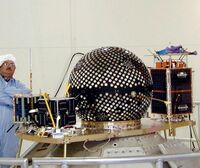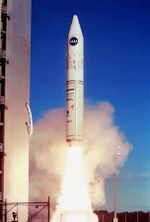SAPPHIRE
Topic: Engineering
 From HandWiki - Reading time: 2 min
From HandWiki - Reading time: 2 min
Short description: U.S. amateur radio satellite
 SAPPHIRE satellite | |
| Mission type | Communications |
|---|---|
| Operator | USNA / University of Santa Clara |
| COSPAR ID | 2001-043D[1] |
| SATCAT no. | 26932 |
| Mission duration | 2 years and 6 months |
| Spacecraft properties | |
| Manufacturer | Stanford University |
| Launch mass | 16 kg (35 lb) |
| Start of mission | |
| Launch date | 30 September 2001, 02:40 UTC |
| Rocket | Athena 1 LM-001 |
| Launch site | Kodiak LP-1 |
| Contractor | Lockheed Martin |
| End of mission | |
| Disposal | Decommissioned |
| Last contact | 2005 |
| Orbital parameters | |
| Reference system | Geocentric |
| Regime | Low Earth |
| Eccentricity | 0.0[1] |
| Altitude | 794 km (493 mi)[1] |
| Inclination | 67°[1] |
| Period | 101 minutes[1] |
| Epoch | 30 Sep 2001[1] |
OSCAR | |
SAPPHIRE (Stanford AudioPhonic PHotographic IR Experiment, also called Navy-OSCAR 45) was a satellite built by the Stanford University students in Palo Alto, California.[1]
The satellite was launched on September 30, 2001 together with Starshine 3, PICOSat and PCSat on an Athena 1 rocket at the Kodiak Launch Complex, Alaska, United States .
Its purpose was the training of students, the operation of an infrared sensor, a digital camera, a speech synthesizer and from 2002 the operation of an APRS digipeater.[2] He also served to train midshipmen of the US Naval Academy in the field of satellite control.
The satellite's mission ended in early 2005.
Frequencies
- Uplink: 145.945 MHz
- Downlink: 437.1 MHz
- Mode: 1200 bit/s AFSK
- Call sign: KE6QMD[3]
See also
- OSCAR
External links
References
- ↑ 1.0 1.1 1.2 1.3 1.4 1.5 1.6 NASA Goddard Space Flight Center. "SAPPHIRE". https://nssdc.gsfc.nasa.gov/nmc/spacecraft/display.action?id=2001-043D. Retrieved February 15, 2020.
- ↑ "SAPPHIRE (Stanford AudioPhonic Photographic IR Experiment)". https://directory.eoportal.org/web/eoportal/satellite-missions/s/sapphire-stanford. Retrieved 15 Feb 2020.
- ↑ n2yo.com. "SAPPHIRE". https://www.n2yo.com/satellite/?s=26932. Retrieved 15 Feb 2020.
 |
Licensed under CC BY-SA 3.0 | Source: https://handwiki.org/wiki/Engineering:SAPPHIRE2 views | Status: cached on August 08 2024 03:10:47↧ Download this article as ZWI file
 KSF
KSF
